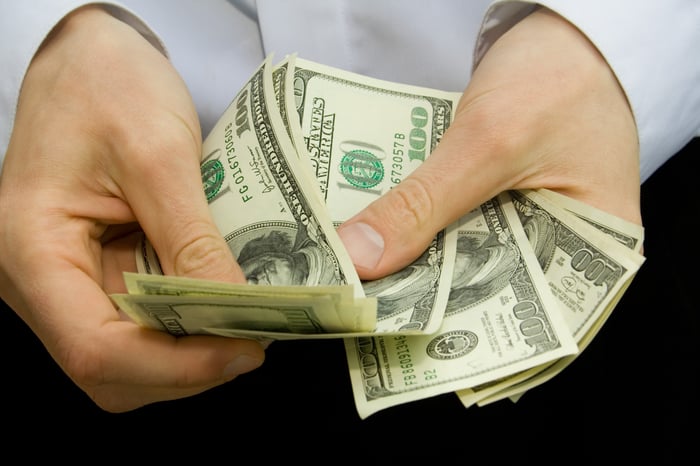Although there are a lot of successful investing strategies on Wall Street, few have more consistently delivered for investors over the long-term than buying dividend stocks.
Back in 2013, J.P. Morgan Asset Management, a division of money-center bank JPMorgan Chase, released a report comparing the performance of dividend-paying stocks to non-dividend payers over a 40-year period (1972-2012). The result? Dividend stocks crushed the non-payers with an average annual return of 9.5% versus 1.6% for the non-payers.
But even among income stocks, no two are alike. There's a special breed of more than five dozen income stocks known as "Dividend Aristocrats" that are revered for their willingness to return capital to shareholders. A Dividend Aristocrat is an S&P 500 company that's increased its base annual payout for at least 25 consecutive years.

Image source: Getty Images.
Following the recent pullback in the broader market, two Dividend Aristocrats stand out for all the right reasons and can confidently be purchased hand over fist. Meanwhile, another trusted Dividend Aristocrat is best off avoided.
Dividend Aristocrat No. 1 to buy: Walgreens Boots Alliance
The first incredible dividend stock begging to be bought is pharmacy chain Walgreens Boots Alliance (WBA -1.18%). Walgreens has been paying a regularly quarterly dividend for more than 89 years, and it's increased its base annual payout in each of the past 46 years. Its 4.1% yield is the highest among the Dividend Aristocrats I'm discussing today.
Pardon the pun, but healthcare stocks are generally immune to economic downturns. Even though the share prices of healthcare stocks may move lower in sympathy with the broader market, people don't stop getting sick just because of recessions or stock market corrections. The persistent need for healthcare services and prescription medicines is what makes healthcare stocks so defensive.
While this defensive aspect has helped Walgreens in the past, it didn't save the company from being clobbered during the initial stages of the COVID-19 pandemic. Since pharmacy chains are primarily reliant on foot traffic, lockdowns really weighed on front-end retail sales and clinic revenue. But the good news for income investors is it means they can scoop up shares of Walgreens at an extremely attractive valuation.
Walgreens Boots Alliance is in the midst of executing on a multipoint growth strategy designed to improve its operating margins, boost organic growth opportunities, and build brand loyalty.
For example, the company has reduced its annual operating expenses by more than $2 billion a year ahead of schedule, and it divested its drug wholesale business, Alliance Healthcare, to AmerisourceBergen in June 2021 to reduce its debt load. All the while, it's aggressively spent on digitization efforts designed to boost direct-to-consumer sales. Even though Walgreens will always be reliant on foot traffic, online sales are a no-brainer way to boost its organic growth potential.
The company is also working with (and investing in) VillageMD to open more than 600 co-located, full-service health clinics in over 30 U.S. markets by the end of 2025. These clinics are differentiated by being physician-staffed and are the perfect tool to build a loyal following of repeat patients/customers.
Sporting a forward-year price-to-earnings multiple of around 9, Walgreens is a value-based high-yield company income investors can trust for years to come.

Image source: Getty Images.
Dividend Aristocrat No. 2 to buy: NextEra Energy
Another Dividend Aristocrat income seekers can confidently buy hand over fist is electric utility stock NextEra Energy (NEE 0.51%). NextEra has increased its base annual payout for 28 consecutive years and is currently parsing out a 2.1% yield. Keep in mind that the only reason this yield is below the industry average for utility stocks is because NextEra's shares have risen 380% over the trailing 10-year period.
Over the past couple of months, NextEra's steady march higher has hit a few snags. For starters, skeptics are concerned about how higher lending rates might impact the company's infrastructure projects. Additionally, CEO John Ketchum divulged last week that the U.S. Department of Commerce launched a probe in late March that could result in hefty retroactive tariffs on solar panel imports from Southeast Asian nations. The uncertainty surrounding these tariffs may cause NextEra to delay some of its solar projects until next year.
While both of these concerns are tangible, they overlook the predictability of cash flow associated with utility stocks, as well as fail to recognize NextEra's clear-cut competitive advantages.
What allows NextEra Energy to stand out is the company's leading renewable energy assets. No electric utility in the country comes close to the capacity NextEra can generate from wind or solar. Despite these projects being costly, they're helping to significantly lower electricity generation costs, which in turn has lifted the company's compound annual growth rate to the high single digits for more than a decade.
NextEra is also benefiting from its regulated utility operations -- i.e., those not powered by a renewable energy source. Although regulation means the company can't raise rates on a whim, it also ensures it isn't exposed to potentially volatile wholesale electricity pricing. This ties back into the predictability of the company's operating cash flow.
With NextEra targeting 10% annual dividend growth through at least 2024, this stock looks like a safe bet for patient income seekers.

Image source: Getty Images.
The Dividend Aristocrat to avoid like the plague: Clorox
On the other side of the coin is brand-name consumer staples stock Clorox (CLX -0.19%). The company behind an assortment of well-known cleaning products sports a 3.1% dividend yield and has increased its base annual payout for 44 consecutive years.
Clorox found itself in the right place when the COVID-19 pandemic hit. A company known for products designed to clean surfaces and kill bacteria was perfectly positioned to take advantage of the initial stages of the pandemic. Between 2019 and 2021, Clorox's annual sales jumped from $6.21 billion to $7.34 billion.
Unfortunately for Clorox, the uncertainty that fueled consumers to purchase cleaning products has subsided. While the pandemic isn't over, it would appear that worst of the COVID-19 pandemic is now in the rearview mirror. Recent variants of the disease have led to lower mortality rates when compared to the initial strain and other key variants.
If there's a silver lining for Clorox, it's that the company's well-known brands typically command strong pricing power. When combined with historically high inflation, Clorox hasn't had any issues passing along higher costs to consumers. The issue is that Clorox can't raise its prices fast enough to offset the drop in organic demand for its products. The company's fiscal second quarter, which ended Dec. 31, 2021, featured a 10% decline in volume and an 8% drop-off in organic sales.
In addition to Clorox's Health and Wellness segment reversing course from its unsustainable boost during the pandemic, shares of the company remain unattractive even following a 38% decline since hitting its all-time intra-day high in August 2020. We're talking about a consumer goods company that typically grows sales by a low single-digit percentage that's being valued at an aggressive 26 times Wall Street's forward-year earnings consensus. There are dozens of dividend stocks with forward-year price-to-earnings ratios below 26 that also sport growth rates well above 2% to 3% annually.
Clorox is a Dividend Aristocrat that income investors should avoid.





